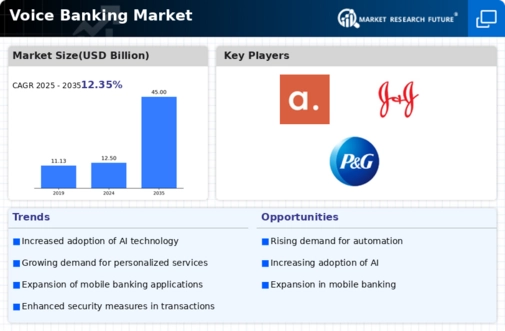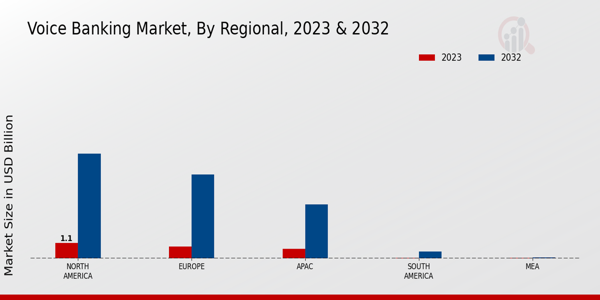Market Growth Projections
The Global Voice Banking Market Industry is poised for substantial growth, with projections indicating a market size of 12.5 USD Billion in 2024 and an anticipated expansion to 45 USD Billion by 2035. This trajectory reflects a compound annual growth rate of 12.35% from 2025 to 2035, underscoring the increasing adoption of voice banking solutions across various demographics. The growth is likely driven by advancements in technology, changing consumer preferences, and the rising demand for seamless banking experiences. Such projections highlight the potential for voice banking to become a dominant force in the financial services landscape.
Enhanced Security Features
Security remains a paramount concern in the Global Voice Banking Market Industry, prompting advancements in voice recognition technology. Financial institutions are investing in sophisticated biometric authentication methods to ensure secure transactions. The integration of voice biometrics not only enhances security but also improves user experience by streamlining the authentication process. As a result, customers may feel more confident in utilizing voice banking services, potentially driving market growth. The emphasis on security features is likely to play a crucial role in shaping consumer trust and adoption rates in the coming years.
Rising Adoption of Smart Devices
The proliferation of smart devices globally contributes significantly to the Global Voice Banking Market Industry. As consumers increasingly integrate smart speakers, smartphones, and wearables into their daily lives, the demand for voice banking solutions rises. For instance, in 2024, the market is projected to reach 12.5 USD Billion, driven by the convenience and accessibility these devices offer. Users are likely to prefer voice-activated banking services for their efficiency and ease of use, which may lead to a more substantial market presence. This trend suggests a shift towards a more automated and user-friendly banking experience.
Regulatory Support and Compliance
Regulatory frameworks play a pivotal role in shaping the Global Voice Banking Market Industry. Governments worldwide are increasingly recognizing the potential of voice banking and are establishing guidelines to ensure consumer protection and data security. This regulatory support may encourage financial institutions to adopt voice banking technologies more readily. As compliance becomes a priority, banks are likely to invest in voice solutions that align with regulatory standards. This trend suggests that a robust regulatory environment could foster innovation and growth within the voice banking sector, ultimately benefiting consumers.
Integration with AI and Machine Learning
The incorporation of artificial intelligence and machine learning into the Global Voice Banking Market Industry is transforming how financial services are delivered. These technologies enable personalized banking experiences, allowing institutions to analyze customer behavior and preferences effectively. By leveraging AI, banks can offer tailored recommendations and services, enhancing customer satisfaction. This trend indicates a shift towards more intelligent banking solutions, which may attract a broader customer base. As the market evolves, the synergy between voice banking and AI could lead to innovative offerings that redefine customer engagement in the financial sector.
Growing Demand for Contactless Transactions
The Global Voice Banking Market Industry experiences a surge in demand for contactless transactions, particularly in the wake of evolving consumer preferences. As individuals seek safer and more convenient banking methods, voice banking emerges as a viable solution. This shift is evident as financial institutions increasingly adopt voice technology to facilitate secure transactions. The market's growth trajectory indicates a potential expansion to 45 USD Billion by 2035, reflecting a compound annual growth rate of 12.35% from 2025 to 2035. Such trends suggest that voice banking could become a cornerstone of modern banking practices.





